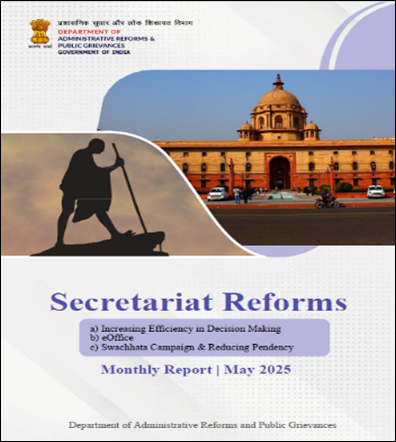DARPG’s May 2025 Report Showcases Digitized, Efficient, and Clean Governance
These reforms are framed within the larger ethos of "Minimum Government, Maximum Governance", and reaffirm the commitment to Digital India and responsive citizen service delivery.

- Country:
- India
The Department of Administrative Reforms and Public Grievances (DARPG) under the Ministry of Personnel, Public Grievances and Pensions has released the 22nd edition of its monthly ‘Secretariat Reforms’ report, spotlighting notable progress made in May 2025 towards reforming India’s administrative framework. The report outlines transformative steps taken across ministries to enhance cleanliness, reduce administrative pendency, digitize workflows, and boost decision-making efficiency—key themes that form the foundation of modern, responsive governance.
Focus Areas of the May 2025 Edition
The report comprehensively covers advancements under the following pillars:
-
Swachhata and Pendency Reduction
-
Efficiency in Decision-Making
-
e-Office Implementation and Analytics
-
Best Practices in E-Waste Disposal
-
State-Level Replication of Good Governance
-
Cabinet Secretariat Directions on e-Governance
These reforms are framed within the larger ethos of "Minimum Government, Maximum Governance", and reaffirm the commitment to Digital India and responsive citizen service delivery.
1. Swachhata and Reduction in Pendency
Under the ongoing cleanliness and decluttering campaigns, the government achieved significant milestones:
-
8,835 sites across the country underwent structured cleanliness drives, freeing up nearly 3.5 lakh square feet of office space.
-
Top contributors included:
-
Ministry of Railways: 1,30,180 sq. ft.
-
Ministry of Coal: 76,231 sq. ft.
-
-
-
A record ₹284.84 crore in revenue was generated from scrap disposal, with major contributions from:
-
Railways
-
Ports, Shipping and Waterways
-
Heavy Industries
-
Between December 2024 and May 2025, cumulative figures indicate a total of ₹3,163.97 crore earned through scrap disposal initiatives.
Further, under efficient record management:
-
1,04,941 physical files were reviewed
-
66,186 files were weeded out
-
4,57,081 public grievances were resolved (89.79% disposal rate)
-
Disposition of:
-
1,448 MP references
-
320 State Government references
-
These efforts underscore a deep institutional shift toward decluttering and faster grievance redressal.
2. Best Practices: E-Waste Disposal
The Department of Atomic Energy’s AMD Headquarters in Hyderabad was highlighted for its exemplary practices in e-waste disposal, setting a benchmark for efficient space utilization and promoting environmentally responsible public administration.
These measures not only advance the Swachh Bharat Mission but also align with India’s environmental sustainability goals by managing and disposing of electronic waste responsibly.
3. Boosting Efficiency in Decision-Making
The report details remarkable strides in reducing bureaucratic delays through delayering initiatives:
-
The average distinct transaction levels for active files dropped from 7.19 (in 2021) to 4.17 (May 2025)—a significant indicator of streamlined workflows and quicker decision-making.
This transformation is directly attributed to rationalization of processes and restructuring of authority levels, fostering leaner and faster decision pathways across ministries.
4. Accelerated e-Office Adoption
The government has aggressively adopted e-Governance tools to ensure faster communication, transparency, and accountability:
-
95.47% of all files created in May 2025 were e-Files
-
95% of receipts received were in electronic format
-
40 Ministries/Departments reported 100% adoption of e-Files
-
15 Ministries/Departments achieved 100% share of e-Receipts
-
3,892 inter-ministerial file movements were recorded digitally, showcasing operational synergy across departments
These achievements are built on the success of the e-Office platform, an initiative championed by DARPG, which enables real-time file tracking, inter-departmental coordination, and secure digital workflows.
5. Cabinet Secretariat Push for e-Governance
In line with broader Digital India goals, Cabinet Secretariat directives further reinforce the urgency of achieving universal e-File and e-Receipt adoption, ensuring that all central ministries embrace full-fledged digitization by default.
6. State-Level Replication of Best Practices
Another key feature of the May 2025 report is the highlight on replication of good governance practices at the state level, illustrating how reforms pioneered at the Centre are being effectively localized.
States have adopted DARPG’s models for:
-
File digitization
-
Grievance redressal optimization
-
Space utilization through scrap and e-waste disposal
These cases showcase how inter-governmental collaboration continues to drive governance innovation nationwide.
7. Ministry in Focus: Ministry of Coal
This month’s edition places a spotlight on the Ministry of Coal, applauding its substantial contribution to:
-
Office space optimization (76,231 sq. ft)
-
Active e-Office adoption
-
Compliance with cleanliness and digitization directives
Its leadership in these areas positions it as a model ministry for administrative reform.
A Governance Model in Motion
The May 2025 Secretariat Reforms report not only documents the significant milestones in administrative efficiency but also reflects the changing DNA of public service delivery in India—leaner, greener, cleaner, and digital-first. With over 95% digital transactions in some ministries and major strides in waste disposal and decision-making efficiency, the Government of India continues to make governance citizen-centric and performance-driven.
DARPG’s consistent monthly reporting and real-time metrics underscore its commitment to data transparency, enabling both public and institutional accountability. The Secretariat Reforms initiative stands as a vital cog in India’s journey toward 21st-century governance excellence.










